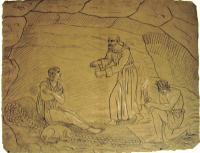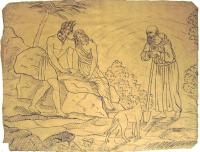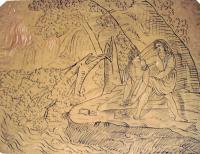Here are a few drawings illustrating Chateaubriand’s Atala from a portfolio donated by Princeton University Professor Emeritus and Chateaubriand scholar Gilbert Chinard. For the complete story of how he acquired them from the Librairie Philosophique J. Vrin at 6, Place de la Sorbonne in Paris, see the Princeton University Library Chronicle XXVI, no. 3 (Spring 1965) http://libweb5.princeton.edu/visual_materials/pulc/pulc_v_26_n_3.pdf.
Mr. Vrin told Chinard that the drawings were by an amateur artist from Dijon known as Comte de Boulet, presumably executed around 1810-20 for an illustrated edition of Atala, ou les Amours de deux sauvages dans le désert written by François-Auguste-René, vicomte de Chateaubriand (1768-1848). The edition was never published and Princeton’s two blue buckram portfolios housing thirty-two drawings appears to be the only remaining evidence of the project.
When Atala was published in 1801 it was an immediate success. Inspired by Chateaubriand’s trip to the American South ten years earlier, the story is told through the reminiscences of Chactas, an elderly native of the Louisiana territory raised with a Seminole Indian tribe. Chactas loves Atala, who is a dedicated Christian, and the novella contrasts their two backgrounds and religious philosophies. Chateaubriand describes the book as a “painting of two lovers who walk and talk in solitude; all lies in the picture of the turmoil and love in the midst of the calm of the wilderness.”
Boulet’s drawings have been exhibited at least once, in the 1976 exhibition at the Grand Palais organized by Hugh Honour under the title L’Amérique vue par l’Europe. Firestone Annex A N6754 .H762
To listen to a French reading of the story, see: http://www.litteratureaudio.com/livre-audio-gratuit-mp3/chateaubriand-francois-renede-atala.html.
Theophile de Boulet, Chateaubriand’s Atala, ca. 1810. Pencil, crayon, and ink drawings with gouache highlights. Graphic Arts GC100.




